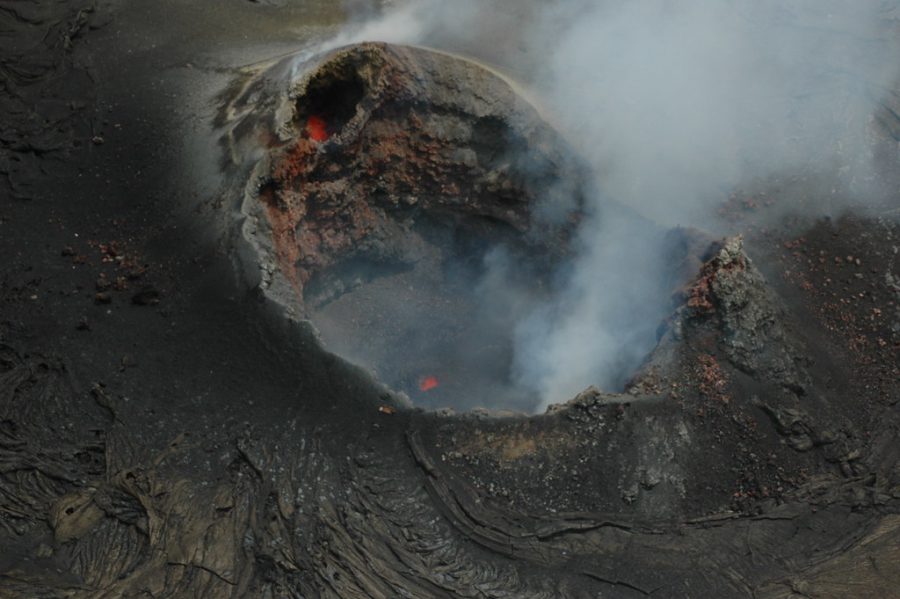Mauna Loa seismic activity puts Hawaii residents on alert
November 20, 2022
Recent earthquakes and seismic activity have put residents near Mauna Loa, the world’s largest active volcano, under alert, but scientists assure that the volcano is not going to erupt anytime soon.
Located in Hawaii, Mauna Loa makes up one of five volcanoes located on the Big Island. Despite not being the tallest volcano, Mauna Loa is the largest and makes up half of the island’s land mass.
According to the Hawaiian Volcano Observatory of the U.S. Geological Survey, or USGS, the volcano is under “Yellow” advisory alert, meaning that Mauna Loa is exhibiting signs of “heightened unrest as indicated by increasing earthquake activity and inflation of the summit.”
The HVO has detected small-magnitude earthquakes about two to three miles below the Mokuʻāweoweo caldera due to a new input of magma.
“The unrest is likely caused by renewed input of magma into Mauna Loa’s summit reservoir system,” the Observatory said. “As the reservoir expands it is triggering small earthquakes directly beneath the Mokuʻāweoweo caldera and in a region just to the northwest of the caldera.”
The series of earthquakes has been occurring since June, from 10 to 20 a day to more than 40 to 50 a day in September. It reached a peak of 100 earthquakes a day on Sept. 23 and 29, according to CNN.
Unlike Kīlauea, located on the southeastern shore of the Big Island, Mauna Loa is taller and hence eruptions might include a faster flow of lava due to its height. It also has a larger magma reservoir which leads to larger lava flows and longer rests between eruptions.
Also unlike Mount St. Helens – a stratovolcano – Mauna Loa is a shield volcano, meaning that the lava flows eventually build mountains that look like a “warrior’s shield,” according to the Associated Press.
The Hawaiian volcano will not have the same explosive eruption as its Washington counterpart, as its magma is hotter and more fluid, according to USGS Alaska Volcano Observatory research geophysicist Hannah Dietterich.
The Hawai’i Volcanoes National Park closed Mauna Loa summit due to the increased activity until further notice, but Mauna Loa Road and Mauna Loa Lookout remain open to the public.
Though the increased activity is cause for some concern, it does not yet indicate that the volcano will erupt any time soon.
“In this case, we have heightened seismicity, and the deformation, the ground is changing but not at a rapid rate to cause alarm,” Frank Trusdell, an HVO geologist, said.
According to Trusdell’s comments during Volcano Awareness Month in 2021, HVO has been preparing for the eventual eruption of Mauna Loa, including adding new instrumentation, upgrading monitoring equipment and coordinating response plans with various agencies including NPS, Civil Defense and FEMA.
Since the volcano’s first-documented eruption in 1843, it has erupted 33 times. During its most recent eruption in 1984, a lava flow came within 4 miles of the town of Hilo, the largest population center on the island.
Luke Meyers, the administrator of the Hawaii Emergency Management Agency, said that with the current alert level, officials are advising a “cautious look at what may be coming” and that it is always “better to be prepared and ready.”
The Hawaii Civil Defense Agency recommended that residents in the area prepare a go-bag filled with food and identify a pre-selected location where they can safely evacuate and meet their family members.
“Not to panic everybody, but they have to be aware of that you live on the slopes of Mauna Loa. There’s a potential for some kind of lava disaster,” Hawaii County Civil Defense Administrator Talmadge Magno said.








